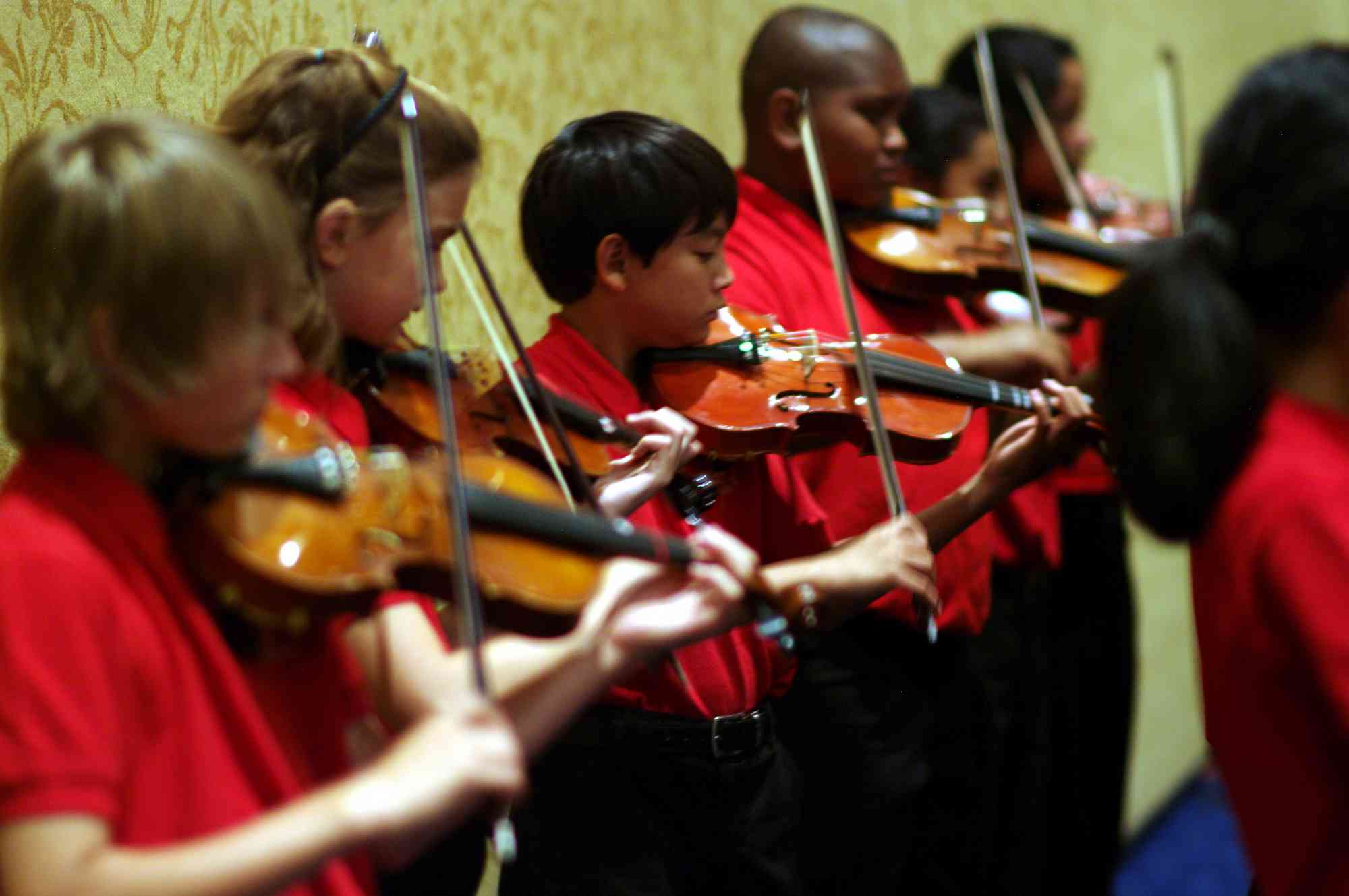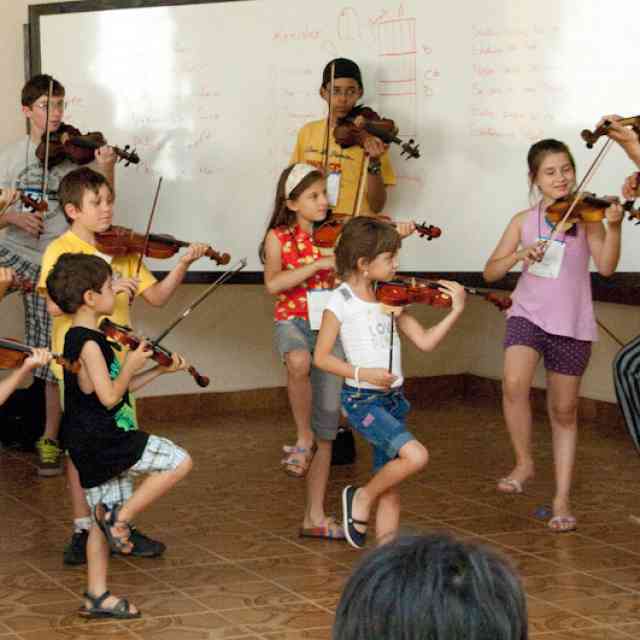The SAA 15th Biennial Conference was a huge success from many perspectives. The days of May 24-28, in Minneapolis were full and inspiring. The Keynote addresses were enlightening and inspiring for all members: Laurel Trainor reviewed research from cognitive and developmental psychology and provided insight regarding the effects of musical experiences on brain development. Brian Lewis emphasized the importance of knowing your audience when performing. He described levels of social and emotional development that influence an individual’s involvement and response.
For those of you who were unable to attend, I’ll briefly review the sessions specific to the Suzuki in the Schools membership. However, I’m hoping you will start to make plans to attend the 2014 Conference. We would like your participation and input at that time but we also encourage communication from you between now and then. Handouts from most of these sessions will be available on line soon. You can also contact the presenters through the SAA Member Directory.
As always, student performances were the most engaging part of the conference. The Parker Elementary School Suzuki Strings Performance on Friday evening at the Opening Reception was a great way to celebrate the impact the Suzuki Method has had on public schools. Theirs was a musical, energetic, and inspiring performance. On Saturday morning, the Parker teachers, Beth Benne, Linda Branch, Timothy Peters, and Lisa Vosdoganes, led the Parker Performing Strings Ensemble through another very inspiring performance/demonstration and lecture session: “Twinkling into the Future.” The teachers, parents, and principal, Dr. Houlihan, described different aspects of the Parker Suzuki program including scheduling, special performance opportunities, parental involvement, and perceived benefits to the children and to the community. The session demonstrated the wonderful work of the teachers, the parents, the students, and the administration at Parker Elementary School.
Also on Friday, Kiki Barley and Jennifer Madge described a summer program, partially funded by the Recovery Act, they designed in Pittsburgh. The session was entitled Suzuki Outreach: The Summer Dreamers Academy of the Pittsburgh Public Schools. Barley and Madge told how they combined the resources and strengths of the Pittsburgh Music Academy with the facilities of the Pittsburgh public schools to benefit 350 elementary school children. They cited research used in their proposal indicating the benefit of exposure to the arts, specifically in underserved populations. They described the problems of collaboration as well as the benefits. They have proposed changes for future programs.
Stacie Herrington, Susan Pugh, and Lisa Vosdoganes, represented three different Suzuki in the Schools programs in their session, How to Make it Work: Parent Education and Communication within the Public School Setting. Stacie Herrington, from Sheldon ISD—near Houston, TX, emphasized the importance of creating a vision of excellence in the child’s future. Herrington sets up expectations of parent commitment from the beginning. Listening is a priority and parents learn to play violins to the level that many play on concerts. Lisa Vosdoganes, from Parker Elementary, in Houston, TX, discussed the importance of communication through timely and carefully crafted information that can be given, spoken, or emailed frequently. Susan Pugh, from HEBISD, near Fort Worth, TX, described technological tools to help parents with practice. She uses a Livescribe smart pen that takes her voice to the practice session and SmartMusic to help guide practice—particularly in early reading.
Following the Parker presentation, on Saturday, Alicia Bont, Daniel Gee, Mary Margaret Haraden teamed up to present Factors that Motivate Students to Learn and Continue to Progress in the Public School Suzuki Program. The panel discussed how the Suzuki Method and philosophy is represented in each of their programs. They represent three different school situations. The session ended with a discussion on maintaining interest. Regardless of the age of the beginning student, the teacher must meet the students where they are—mostly through managing the development of technique or skills in an age-appropriate way. Creating a learning culture is important: everybody has difficulties, we work on solving the problems in a safe environment. Panelists agreed that the best motivation results from good parent education. A good public image is essential.
Mary Margaret Haraden, teaches at Shady Brook Elementary School, in HEBISD, near Fort Worth, TX. She represents a Suzuki program that follows the teacher/parent/child model of most Suzuki programs. The parents attend a lesson with their child each week. Group classes are held at each school on a weekly basis. In addition, the district provides opportunities to combine activities of Suzuki students through workshops and performances. String orchestra opportunities begin in late elementary school and continue through middle school and high school. Two students from the HEBISD district performed in SYOA at this conference.
Alicia Bont, teaches at Shenandoah Valley Elementary, in Parkway School District, St. Louis, MO, where all 3rd grade students attend classes twice a week to learn to play violin. In 4th and 5th grade, they have options to continue or not and/or to change instruments. String orchestra opportunities are available through middle school and high school. There are parent volunteers who help with instruction by assisting the teacher.
Daniel Gee, is from Chisholm Trail Middle School, Round Rock ISD, Austin, TX. In addition he has a private studio in Austin. In his school, students can choose orchestra as an elective class in the 6th grade. Students follow a Suzuki curriculum, learning first by ear and developing skills that parallel pre-Twinkle development, with age-appropriate accommodations. The teacher assumes most of the parent-as-practice partner role; however, parents do have specific assignments in support of their children and the program.
In the session, “Orchestra and Autism: Collaboration, Optimism, and Effective Strategies,” Alicia Bont described how she collaborated with a team of teachers and resource staff at her school in Parkway School District, St. Louis, MO, to create opportunities to include a group of students on the low end of the autistic spectrum in her 6th grade orchestra. The project involved performances, peer teaching, and collaboration with others outside the usual subject area boundaries. She extended the Suzuki philosophy to an often under-served population through the following teaching strategies: Put people first; Make individual accommodations; Simplify Skills; Facilitate positive interactions. Her presentation was comprehensive and inspiring.
“From First Glance to Fluency: An Organic Approach to Teaching Music Literacy” was a session that combined the expertise of Winifred Crock and Dr. Laurie Scott. Mrs. Crock, who teaches at Parkway Central High School, St. Louis, MO, and Dr. Scott, from The University of Texas, Austin, TX, have frequently collaborated on articles and material related to pedagogy and reading music. Their presentation was polished, comprehensive, and well received. For this presentation, Mrs. Crock and Dr. Scott took turns describing literacy as a natural process, emerging from experience. They described a pedagogical sequence for learning based on familiar music that is rooted in skills and knowledge that the child already possesses. Both presenters used and demonstrated techniques to enhance the child’s experience. They frequently emphasized that music literacy should emerge in a natural sequence based on music the child already knows.
On Sunday, a panel of experts presented, “Maintaining Expectations for Excellence in Public and Private School Suzuki Education.” Ian Salmon, from North Euless Elementary School, HEBISD, near Fort Worth, TX, talked about the importance of developing character, an often over-looked by-product of teaching, influenced by the Suzuki philosophy. He referenced a NY Times article by Paul Tough: ‘What if the Secret to Success is Failure.’ Mr. Salmon developed and described a character assessment survey for his students based on those identified by Chris Peterson and Martin Seligman.
Diane Slone is on the faculty at The Hartt School of Music, Hartford, CT, where, among other endeavors, she is involved with the Blue Hills Suzuki Project. Diane spoke of the importance of bringing the life, energy, and joy of learning she experienced in the presence of Dr. Suzuki to her students every day. She referenced ‘Inside Out Learning,’ building critical thinking skills where students figure things out for themselves. Judy Offman, from Sheldon ISD, near Houston, TX, shared the importance of maintaining high expectations. She draws on her experience in the private studio and as a Teacher Trainer to encourage others to aspire to excellence. She taught an ECC course for administrators in Sheldon ISD. Ms. Offman emphasized the importance of parent education. She encouraged us to talk about what may seem like the impossible to parents in the public school setting: attending a summer Institute, joining the SAA, or even planning a trip to Japan.
Following the Suzuki in the Schools sessions, Marilyn Kesler and Patty Purcell hosted a Question/Answer session. The audience had many questions and suggestions directed towards the SAA. There was a request for advocacy resources. Questions included: What is the best way for parents and teachers to approach public or private school administrators? How can we best take the value of music learning to public awareness and especially to those who make curriculum decisions?
Organizations that are sources for funding for music education were mentioned: www.DonorsChoose.org , The Mockingbird Foundation, and VH1 Save the Music.
Thank you to those of you who presented and those of you who were willing to host these sessions and to help us take notes: Anne Donahue, Denae Chance, Lucy Shaw, Winifred Crock, Vincent Pugh, Linda Rekas, Frances Green, and Davis Holden.










